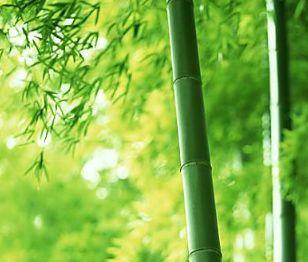Bamboo zhú, bamboo is not only useful, but also elegant and knotted, it is better to eat no meat, not to live without bamboo.

Today we come to know the word "bamboo zhú".
【Glyph evolution】
Bamboo, oracle bones like six leaves hanging down on two thin branches. The jinwen basically inherits the oracle bone glyph. The text strengthens the image of the leaves drooping and the leaves piled into clusters. The seal text inherits the gold glyph. Original meaning: noun, temperate or tropical grasses, hollow, knotted, long shoots. The writing is written as two "ones". In ancient glyphs, "艸" (卄) and "bamboo" are similar but opposite: the leaves are "艸" (草) facing up, and the leaves are "bamboo" facing down.
【Calligraphy Masters】
【Definition of words】
〈Name〉
(Pictograms. Small seal glyphs, resembling bamboo stems with drooping leaves. "Bamboo" is a radical of the Chinese character. Most of the characters from "bamboo" are musical instruments, bamboo utensils, and things that record words. Meaning: bamboo)
Perennial evergreen. The stem has joints and hollows, which can be used for construction, can be used as a raw material for papermaking, and can also be made into musical instruments.
Bamboo, winter grass also. Pictographic. - "The Talk"
Cut the bamboo to take the road, and see the small pond. ——Liu Zongyuan, "The Tale of Little Stone Pond"
The official use of bamboo, all ordered to record thick heads, accumulation like mountains. - "The New Language of the World"
Bamboo slips
Ming (hugging) withered bamboo, keeping empty words, not knowing the appropriateness of giving up, the changes of the times. - "On Salt and Iron"
One of the eight notes of ancient times, referring to a bamboo instrument such as the flute
Silk wood bamboo. - "Zhou Li Chunguan Taishi". Note: "Bamboo, pipe pipe also."
Feasting pleasure, not silk bamboo. ——Ouyang Xiu's "Drunken Pavilion"
bamboo forest
Blatantly hug the straw into the bamboo. --Don S. Du Fu's "Song of the Hut Broken by the Autumn Wind"
【The Story of the Word】
Bamboo stone
Qing Zheng Zheng Xie
Firmly believe that the green mountain does not relax, and the root is in the broken rock.
Thousands of grinding blows are still strong, and Ren'er's east, west, south and north winds are strong.
Translation: Firmly clinging to the green mountain and not relaxing, it was originally deeply rooted in the cracks of the stone. Thousands of grinding blows to the bones are still strong, allowing you to blow east, west, south and north winds.
Interpretation: Zheng Xie (1693~1765), Qing Dynasty calligrapher and poet. Zi Kerou, Banqiao, Xinghua (present-day Xinghua, Jiangsu) people. Good at painting bamboo, orchid, stone, calligraphy is famous for "six and a half books", poetry is also very well written, so it is called "three absolute". His paintings are unique in the world of painting. Together with Luo Ping, Li Fangyi, Li Eel, Jin Nong, Huang Shen, Gao Xiang and Wang Shishen, they are called the "Eight Monsters of Yangzhou".
What the poet praises is not the femininity of bamboo, but the fortitude of bamboo. Regardless of the wind and rain, let the frost and snow freeze, the green bamboo is still "strong" and stands proudly. "Thousands of grinding blows" and "southeast and northwest winds" are extremely harsh tests. This poem borrows things as a metaphor for people, and the author implicitly expresses his noble ideological sentiments that will never go with the flow by chanting the bamboo in the broken rock.